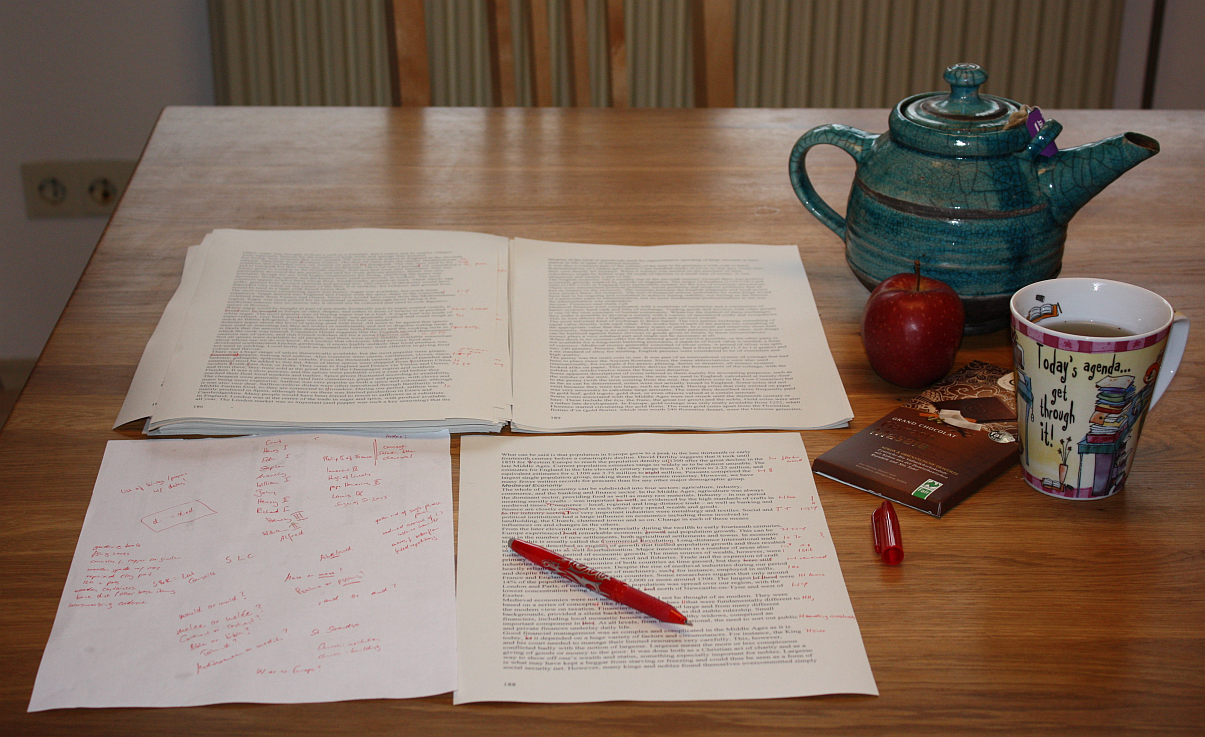Right.
The end is nigh, though, as you can see from the much-diminished stack of paper to the right - the one without all the red speckles at the side and in the text.
In case you are wondering about the speckles in the margin, I'm using a standardised system of correction marks - Germany has that thing about standardising stuff, and this is one of the instances where rules come in really handy. I learned it out of the Duden (something like the Merriam-Webster for German), way back when I first started copyediting. The basic principle, and the most important one: You do a mark in the text where the correction is needed, then you repeat the same mark in the margin and write out the correction. For inserting commas, you strike the mark right through the last letter of the word, then repeat the letter and place a comma behind it in the margin note. For lots of corrections in one line, you need to be inventive with the marks - but it always remains very clear and very unambiguous, and you only need to scan the margin to see where your next correction will be. There are a few additional special marks, such as "close up margin" or "insert margin" or "italicise", but they are not as important as that basic principle.
I've edited many a manuscript using this system, as it's clear and works well even if lots of corrections are needed. The sheet on the bottom left is for note-taking so I can keep track of the things that need it. The chocolate and tea should be obvious, and the apple is there to make it look as if I might choose a healthy snack. (Hah. Maybe I will.)
The cup, by the way, states my intention for this thing and this day!
The end is nigh, though, as you can see from the much-diminished stack of paper to the right - the one without all the red speckles at the side and in the text.
In case you are wondering about the speckles in the margin, I'm using a standardised system of correction marks - Germany has that thing about standardising stuff, and this is one of the instances where rules come in really handy. I learned it out of the Duden (something like the Merriam-Webster for German), way back when I first started copyediting. The basic principle, and the most important one: You do a mark in the text where the correction is needed, then you repeat the same mark in the margin and write out the correction. For inserting commas, you strike the mark right through the last letter of the word, then repeat the letter and place a comma behind it in the margin note. For lots of corrections in one line, you need to be inventive with the marks - but it always remains very clear and very unambiguous, and you only need to scan the margin to see where your next correction will be. There are a few additional special marks, such as "close up margin" or "insert margin" or "italicise", but they are not as important as that basic principle.
I've edited many a manuscript using this system, as it's clear and works well even if lots of corrections are needed. The sheet on the bottom left is for note-taking so I can keep track of the things that need it. The chocolate and tea should be obvious, and the apple is there to make it look as if I might choose a healthy snack. (Hah. Maybe I will.)
The cup, by the way, states my intention for this thing and this day!




